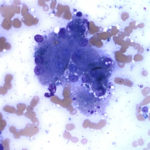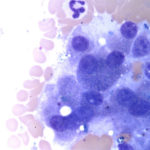Liver aspirate from a dog
Case information
A 9-year-old male castrated Labrador Retriever presented to the Cornell University Hospital for Animals for a 3-day history of vomiting and anorexia and a 1-day history of diarrhea. The dog had been administered carprofen 3 weeks earlier for progressive right forelimb lameness. The dog was up to date on core vaccinations and received a booster for leptospirosis 3 weeks prior. The patient was bright, alert, and responsive with normal vital parameters. No major abnormalities were noted on physical examination. Blood was taken for a hemogram and biochemistry profile and a voided urine was collected and submitted for urinalysis. The hemogram results were within reference intervals. Relevant results for the biochemistry profile and urinalysis are shown below.
| Table 1: Pertinent biochemistry results | |||
| Test | Results | Units | Reference interval |
| ALT | 1,469 H | U/L | 20-98 |
| AST | 299 H | U/L | 14-51 |
| ALP | 198 H | U/L | 17-111 |
| GGT | 3 | U/Ll | 0-6 |
| Total bilirubin* | 1.4 H | mg/dL | 0-0.2 |
| Urea nitrogen | 32 | mg/dL | 10-32 |
| Creatinine | 2.1 H | mg/dL | 0.6-1.4 |
| Glucose | 91 | mg/dL | 63-118 |
| * Mixture of indirect and direct bilirubin | |||
| Table 2: Pertinent urinalysis results | ||
| Test | Results | Units |
| Urine specific gravity | 1.020 | units |
| Protein | 100 (moderate) | mg/dL |
| Glucose | 1000 (large) | mg/dL |
| Bilirubin | Small | |
| Casts | 1-2 granular | /LPF |
Abdominal ultrasonographic results did not reveal any abnormalities. Regardless, the liver was aspirated and smears were submitted for cytologic evaluation. Evaluate the representative photomicrographs of the direct smear of the liver aspirate and answer the questions posed below:
- How would you interpret the changes in the biochemical panel?
- Is a cause for these changes evident in the liver aspirate?
- What is going on in the kidney and how do you explain the renal-related results?
 |
 |
 |
Answers on next page
